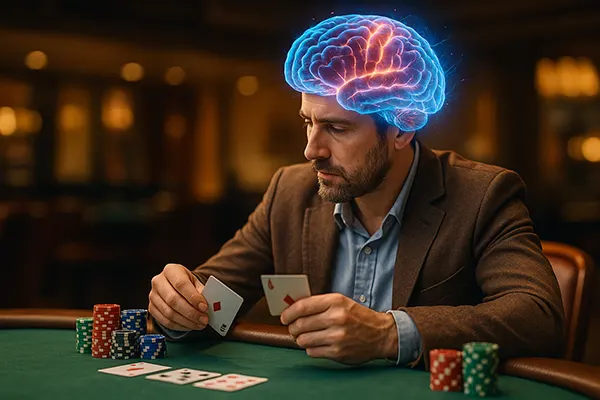
Neuroscience in Poker: What Brain Activity Tells Us About Players
Understanding poker strategy has long been associated with psychology and probability, but neuroscience is offering new perspectives. Through the study of brain activity, researchers uncover how players process risk, manage stress, and make decisions. This growing field is reshaping how we interpret player behaviour at the table.
Neurobiology of Poker Decision-Making
Scientific studies using fMRI and EEG reveal that poker decisions activate brain regions responsible for executive functions. The prefrontal cortex, which governs planning and impulse control, shows increased activity when players assess risks or bluff. This suggests that expert players have honed their ability to manage complex mental calculations under pressure.
Interestingly, skilled poker players often show less activity in the amygdala, the area associated with fear and emotional responses. This may indicate that they’ve trained their brains to regulate emotional reactions, maintaining composure during critical hands. Such control is essential when bluffing or responding to aggressive bets.
Furthermore, neural synchronisation between decision-making and reward processing areas in the brain increases with experience. This suggests that the brain becomes more efficient at linking potential outcomes to strategic choices, allowing seasoned players to operate with sharper precision than novices.
How the Brain Reacts to Bluffing
Bluffing in poker involves deception, which requires active mental management. Neuroimaging studies show heightened activity in the dorsolateral prefrontal cortex when players bluff successfully. This region is essential for suppressing automatic reactions and maintaining a convincing narrative under scrutiny.
Moreover, players who bluff often activate regions linked to cognitive load and working memory. This reflects the mental juggling required to stay consistent with a false story, anticipate opponents’ reactions, and adapt to unexpected moves during the hand.
Some evidence also shows that successful bluffers display reduced physiological stress markers, such as lower heart rate variability. This combination of mental discipline and physical control distinguishes elite players from amateurs and underscores the complex neurology behind poker strategy.
Emotion Regulation and Cognitive Control in Poker
Emotional control is a cornerstone of poker performance, and neuroscience offers insight into how players achieve it. The anterior cingulate cortex (ACC), responsible for error detection and emotional regulation, becomes more active as players confront high-stakes decisions. This suggests a conscious effort to override emotional impulses.
In stressful tournament scenarios, experienced players often exhibit reduced cortisol levels compared to less experienced ones. This hormonal regulation appears to be supported by consistent activity in the ventromedial prefrontal cortex, known for its role in emotion-based decision-making. Thus, mental conditioning can physically alter how the brain responds to pressure.
Additionally, players develop a heightened awareness of internal emotional cues. Recognising frustration, tilt, or overconfidence early allows them to recalibrate their strategy. Brain training techniques such as neurofeedback and mindfulness are increasingly used by professionals to reinforce these control mechanisms.
Dealing with Tilt: The Neuroscientific Perspective
“Tilt”—the loss of emotional control after a bad beat—is not just behavioural. It has a neurological foundation. Brain scans reveal that during tilt, players show a surge in amygdala activity alongside reduced prefrontal engagement, reflecting a dominance of emotion over logic.
To counteract tilt, many players rely on strategies that strengthen executive control. Techniques like meditation or structured breathing activate parasympathetic responses, calming the nervous system and allowing the prefrontal cortex to regain control. Over time, these techniques alter baseline neural responses to stress.
Emerging evidence supports the use of cognitive behavioural therapy (CBT) adapted for poker players. It reinforces patterns of thought that promote resilience and emotional stability, effectively rewiring the brain’s default reactions to negative outcomes.

Experience, Memory and Pattern Recognition
Memory plays a key role in poker. Expert players use episodic memory to recall previous hands and opponent behaviours. Brain scans show increased hippocampal activity during such recollections, especially in players who integrate past experiences into real-time decisions.
Beyond memory, the brain’s pattern recognition capabilities are crucial. The visual cortex and basal ganglia cooperate in identifying betting patterns, timing tells, and facial cues. Over time, this network becomes more responsive, enabling quicker and more accurate reads on opponents.
Repeated exposure and analysis enhance these neural circuits. This is known as “neuroplasticity”—the brain’s ability to adapt. In poker, neuroplasticity allows players to internalise probabilities, scenarios, and opponent tendencies, giving seasoned pros a neurological edge.
The Role of Habit and Intuition
What we often call “intuition” in poker is rooted in the brain’s habit system. Experienced players rely on the striatum, a region linked to automatic behaviour, when making rapid decisions based on minimal cues. This is not guesswork but the result of deep learning and pattern exposure.
Habitual responses develop through reinforcement. When a strategy consistently produces a positive outcome, it becomes encoded as a “go-to” neural pathway. This explains why seasoned players can act decisively without full conscious analysis of every situation.
However, relying solely on intuition can be risky. The balance between instinct and analytical thinking differentiates top-tier players. Neuroscience shows that the integration of habitual systems with executive control networks is what truly defines poker excellence.



